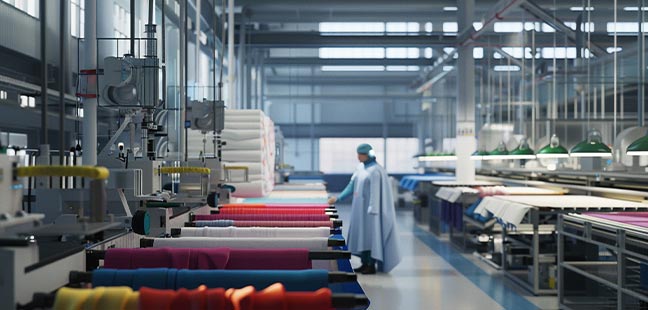How to Become a Textile Technologist
- Pearl Academy Editorial Team
- Published 14-Jan-2025

Table of Contents:
As the textile industry continues to evolve, the demand for skilled textile technologists is on the rise. From eco-friendly fabrics to smart textiles, this field is buzzing with innovation. So, if you're passionate about fabrics and technology, becoming a textile technologist could be your perfect career choice!
Become future-ready with our Fashion Programs
Know MoreWhat is a Textile Technologist?
A textile technologist specializes in developing and improving fabrics and fibers, ensuring they meet specific standards and requirements. This role involves a blend of science, technology, and creativity to innovate and enhance textiles used in fashion, home decor, and technical applications.
Did You Know?
About 10% of global greenhouse gas emissions are from the fashion industry. Sustainable textile technologists are working to reduce this impact.
What is the work of Textile Technologist?
- To increase the effectiveness of their use in the manufacture of fabrics, textile technologists analyze fabrics, fibers, and raw materials.
- When determining which fibers are best suited for creating a particular article of apparel, textile engineers analyze characteristics like heat absorption and allergens in addition to other specifics like color or texture. By examining attributes like fiber composition, sustainability, and ethical methods, they determine which materials are best suited for creating a given item.
- A textile technologist is also in charge of employing synthetic or natural materials to spin fibers into yarn. They use difficult-to-master spinning devices to accomplish this.
- Textile technologists are in charge of verifying quality standards when a facility makes apparel.
Typically, a textile technologist is also in charge of product dyeing and printing.
Why Choose a Career in Textile Technology?
- High Demand: The global textile market was valued at $993 billion in 2021 and is expected to reach $1.23 trillion by 2026, growing at a CAGR of 4.4%.
- Diverse Applications: Textile technologists work in various sectors, from fashion to automotive and medical industries.
- Innovation-driven: With advancements in sustainable and smart textiles, there are endless opportunities for innovation.
For those looking to take their passion further and lead their own ventures in this dynamic industry, explore our guide on How to Become an Entrepreneur in the Textile Industry to learn about building a thriving business in textiles.
Which Course is Best for Textiles?
Pursue B.Des. in Textile Design: A Bachelor's degree in Textile Design provides students with a thorough understanding of textiles, highlighting their significance in the fashion and leisure sectors, as well as their increasing demand in other industries like interiors and automotive.
Students will also learn about the technical and creative sides of various textiles, which will help them solve problems and think independently. A Bachelor's degree will also enable students to investigate the convergence of the digital and physical worlds, with a particular emphasis on smart textiles and the role of technology in them.
Steps to Become a Textile Technologist
1. Get a Relevant Degree
Getting a B.Des. in Textile Design is more advantageous if you're eager to enter the field and are content to work toward different promotions. Apart from gaining a relevant degree, Textile technologists require a high level of technical knowledge, including the manufacturing, processing, and treatment of materials.
2. Develop Key Skills
- Technical Skills: Knowledge of textile machinery, fibers, and testing techniques.
- Analytical Skills: Ability to conduct fabric analysis and quality control.
- Innovation Skills: Creativity in developing new fabrics and applications.
3. Gain Practical Experience
- Internships: Many textile companies offer internships where you can work on real-world projects.
- Laboratory Work: Familiarize yourself with textile labs, as they play a crucial role in testing and development.
4. Stay Updated with Industry Trends
- Sustainable Textiles: Green fabrics like organic cotton and recycled polyester are becoming popular. 73% of global consumers prefer brands that use sustainable fabrics.
- Smart Textiles: A booming field where fabrics integrate technology, like clothes with embedded sensors. The smart textile market is projected to reach $13.63 billion by 2024.
Facts for Aspiring Textile Technologists
- Top Employers: Companies like Nike, Adidas, and Patagonia are leaders in textile innovation.
- Growth Areas: Sustainable fabrics, smart textiles, and technical textiles are the fastest-growing sectors.
How to Become a Garment Technologist?
- Education Matters: A degree in textile technology or a related field is essential for building a career in this field.
- Hands-On Experience: Practical experience through internships or lab work will give you a competitive edge.
- Stay Updated: Familiarize yourself with trends like sustainable and smart textiles, as they are reshaping the industry.

Student Guidance Center: Our Counselors are Just a Click Away.
Conclusion
Becoming a textile technologist offers a chance to blend science with creativity and make a meaningful impact on a rapidly growing industry. With the right education, skills, and passion, you can become part of the next generation of textile innovators. Whether it’s creating eco-friendly fabrics or designing smart textiles, the future of this field is bright and full of opportunities!
Pearl Academy Editorial Team
Tags
- #Fashion
Pearl Admission Enquiry
Subscribe to Pearl Blogs
By clicking the "Subscribe" button, I agree and accept the privacy policy of Pearl Academy.
























































